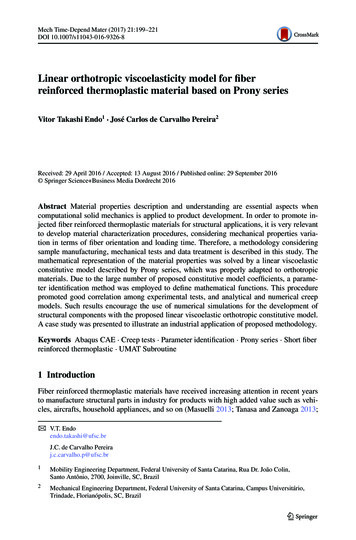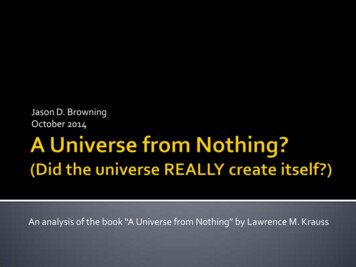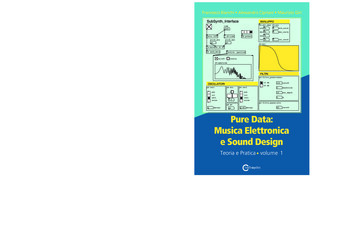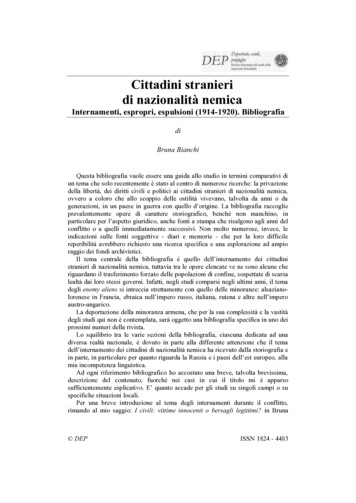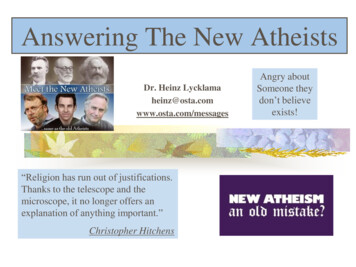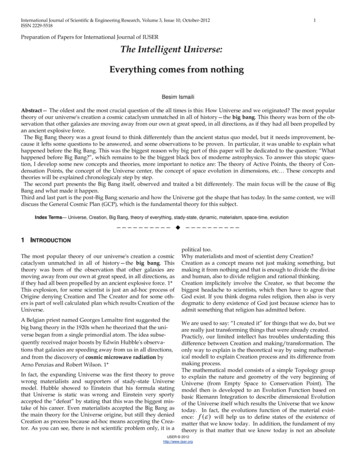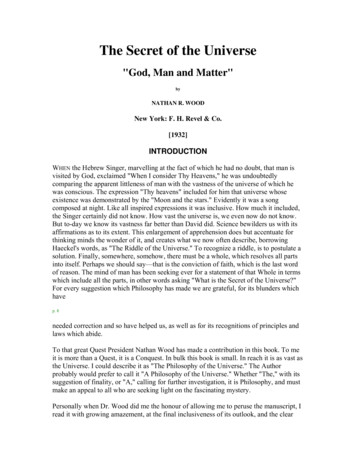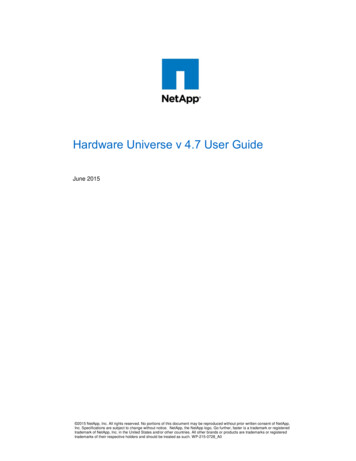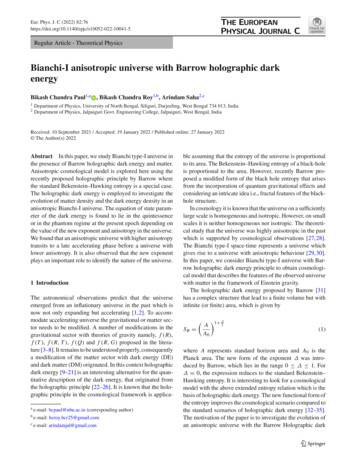
Transcription
Eur. Phys. J. C (2022) -5Regular Article - Theoretical PhysicsBianchi-I anisotropic universe with Barrow holographic darkenergyBikash Chandra Paul1,a , Bikash Chandra Roy1,b , Arindam Saha2,c12Department of Physics, University of North Bengal, Siliguri, Darjeeling, West Bengal 734 013, IndiaDepartment of Physics, Jalpaiguri Govt. Engineering College, Jalpaiguri, West Bengal, IndiaReceived: 10 September 2021 / Accepted: 19 January 2022 / Published online: 27 January 2022 The Author(s) 2022Abstract In this paper, we study Bianchi type-I universe inthe presence of Barrow holographic dark energy and matter.Anisotropic cosmological model is explored here using therecently proposed holographic principle by Barrow wherethe standard Bekenstein–Hawking entropy is a special case.The holographic dark energy is employed to investigate theevolution of matter density and the dark energy density in ananisotropic Bianchi-I universe. The equation of state parameter of the dark energy is found to lie in the quintessenceor in the phantom regime at the present epoch depending onthe value of the new exponent and anisotropy in the universe.We found that an anisotropic universe with higher anisotropytransits to a late accelerating phase before a universe withlower anisotropy. It is also observed that the new exponentplays an important role to identify the nature of the universe.1 IntroductionThe astronomical observations predict that the universeemerged from an inflationary universe in the past which isnow not only expanding but accelerating [1,2]. To accommodate accelerating universe the gravitational or matter sector needs to be modified. A number of modifications in thegravitational sector with theories of gravity namely, f (R),f (T ), f (R, T ), f (Q) and f (R, G) proposed in the literature [3–8]. It remains to be understood properly, consequentlya modification of the matter sector with dark energy (DE)and dark matter (DM) originated. In this context holographicdark energy [9–21] is an interesting alternative for the quantitative description of the dark energy, that originated fromthe holographic principle [22–26]. It is known that the holographic principle in the cosmological framework is applicaa e-mail:bcpaul@nbu.ac.in (corresponding author)b e-mail:bcroy.bcr25@gmail.comc e-mail:arindamjal@gmail.comble assuming that the entropy of the universe is proportionalto its area. The Bekenstein–Hawking entropy of a black-holeis proportional to the area. However, recently Barrow proposed a modified form of the black hole entropy that arisesfrom the incorporation of quantum gravitational effects andconsidering an intricate idea i.e., fractal features of the blackhole structure.In cosmology it is known that the universe on a sufficientlylarge scale is homogeneous and isotropic. However, on smallscales it is neither homogeneous nor isotropic. The theoretical study that the universe was highly anisotropic in the pastwhich is supported by cosmological observations [27,28].The Bianchi type-I space-time represents a universe whichgives rise to a universe with anisotropic behaviour [29,30].In this paper, we consider Bianchi type-I universe with Barrow holographic dark energy principle to obtain cosmological model that describes the features of the observed universewith matter in the framework of Einstein gravity.The holographic dark energy proposed by Barrow [31]has a complex structure that lead to a finite volume but withinfinite (or finite) area, which is given by SB AA0 1 Δ2(1)where A represents standard horizon area and A0 is thePlanck area. The new form of the exponent Δ was introduced by Barrow, which lies in the range 0 Δ 1. ForΔ 0, the expression reduces to the standard Bekenstein–Hawking entropy. It is interesting to look for a cosmologicalmodel with the above extended entropy relation which is thebasis of holographic dark energy. The new functional form ofthe entropy improves the cosmological scenario compared tothe standard scenarios of holographic dark energy [32–35].The motivation of the paper is to investigate the evolution ofan anisotropic universe with the Barrow Holographic dark123
76 Page 2 of 7Eur. Phys. J. C (2022) 82:76energy [36] and to obtain an accelerated universe in the lateepoch.The paper is organized as follows: In Sect. 2 Bianchitype-I space-time and basic field equations in a four dimensional Einstein gravity are given. In Sect. 3 we discuss theisotropization of the Bianchi-I universe. The Barrow holographic dark energy and corresponding equations are discuss in Sect. 4. In Sect. 5, the evolution of dark energy density parameter and equation of state parameter are analyzed.Finally, in Sect. 6, we give brief discussions.We denote the average scale factor of the Bianchi-I universe by a(t) which is given by1a(t) (ABC) 3 .(10)The Hubble parameters in different axial directions are H1 ȦḂĊA , H2 B and H3 C , therefore, we define an averageHubble parameter H which is given by1 ȧ Hi .a33H (11)i 1In terms of the Hubble parameters in the axial directions theEqs. (5)–(8) can be expressed as2 Einstein’s field equationsH1 H2 H2 H3 H3 H1 8π Gρ,(12)We consider anisotropic Bianchi I space-time metric givenbyḢ2 Ḣ3 H2 H3 8π G p,(13) H3 H1 8π G p,(14)ds dt A (t)d x B (t)dy C (t)dz ,Ḣ1 Ḣ2 H1 H2 8π G p,(15)22222222(2)where A, B and C are the directional scale factors, and arethe functions of the cosmic time t. The Bianchi I space-timebecomes isotropic if all the directional scale factor becomessame and we get usual FRW space-time. We assume thatthe cosmic matter is represented by the energy–momentumtensor as followsTμν (ρ p)u μ u ν pgμν ,(3)where ρ is the energy density of the cosmic matter, p is itspressure and u μ is the four velocity vector such that u μ u μ 1.The Einstein field equation is given byRμν 1Rgμν 8π GTμν ,2(4)where Rμν , R and gμν are the Ricci tensor, Ricci scalar andthe metric tensor respectively with the Newton’s gravitationalconstant G. The non zero components of the field Eq. (4) forthe metric (2) and the energy–momentum tensor (3), yieldḢ3 Ḣ1 H22H32H12 H32H12H22and the energy–momentum conservation Eq. (9) is given byρ̇ 3H (ρ p) 0.(16)Now the volume expansion (Θ), the average anisotropicexpansion rate (A), shear (σ ) and the deceleration parameter(q) are given byΘ 3H,A 133 i 1ΔHiH(17) 2,(18)1σμν σ μν ,(19)2äḢq 1 2 ,(20)aH2Hwhere, ΔHi Hi H and σμν is the sheer tensor.For the Bianchi-I anisotropic metric given by Eq. (2) weexpress the shear tensor asσ2 σμν σ μν 3 (Hi H )2 H12 H22 H32 3H 2 . (21)i 1ȦAB̈BÄAÄAḂḂ Ċ BBCC̈Ḃ Ċ CBCC̈Ȧ Ċ CACB̈Ȧ Ḃ BABȦ Ċ 8π GρAC(5)Using Eqs. (12), (19) and (21) we obtain the time-time component of the field equation as 8π Gp,(6)3M 2p H 2 ρ M 2p σ 2 , 8π Gp,(7) 8π Gp.(8)The energy conservation equation Tμν ;ν 0, yields ρ̇ (ρ p)123ḂĊȦ ABC 0.(9)(22)where M p 1 is the Plank mass.8π GThereafter, using the Eqs. (12)–(15), (19) and (21), we obtainthe following 2 Ḣ1 Ḣ2 Ḣ3 9H 2 3σ 2 24π G p.(23)Now, differentiating Eq. (11) once with respect to t, it yields ä1 2 H Ḣ1 Ḣ2 Ḣ3(24)a3
Eur. Phys. J. C (2022) 82:76Page 3 of 7 76Eqs. (20), (23) and (24) leads toM 2p H 2 (2q 1) p M 2p σ 2 .(25)To determine shear tensor we use Eqs. (13)–(15) and obtaind( Ḣi Ḣ j )dV, Hi H jVfor i j and i, j 1, 2, 3 and V ABC. Onintegration we get the following 2k j(26)Hi H j V where 2k1 , 2k2 and 2k3 are the integration constant.The shear tensor is given bya3σμν σ μν 3 A B C, , constanta a a(31)when t .The anisotropic Bianchi-I universe satisfying the aboveisotropization criterion becomes isotropic. In particular, itsdynamics becomes FRW if the constant is unity.4 Cosmological models with Barrow holographic darkenergy(Hi H )2i 11 (H2 H1 )2 (H3 H2 )2 3 (H1 H3 )2 .(27)Finally the sheer scalar (σ ) can be expressed askσ ,3a 3(28)3 Isotropization of Bianchi-I universeThe present universe is isotropic and homogeneous whichmay have attained by an asymptotic situation emerged froman anisotropic universe, namely, Bianchi-I universe thatformed at the phase transition of matter decoupling era.For this we define an isotropization criterion to distinguishanisotropic universe from an isotropic universe which however evolves in such a way that the effect of the anisotropicparameter is negligible at the present epoch z 0. We studyin this section the mean anisotropic parameter A and shearscalar σ in the anisotropic Bianchi-I universe as defined bythe Eqs. (18) and (19) at the present epoch which are givenby 3 1 ΔHi 2 03HThe standard holographic dark energy is given by the inequality ρ D E L 4 S, where L is the horizon length, and imposingthe inequalities S A L 2 . We consider here a modifiedform of density introduced by Barrow to define the entropycaused by quantum-gravitational effects, which yieldsρ D E C L Δ 2 ,where we denote k k12 k22 k32 in terms of the integration constant. It is important to mention here that although33 0 one gets i 1ki 0.k 2 i 1A Also, isotropization defined by the expansion factor of theBianchi-I universe grows at the same rate at the late stageof evolution, when t t0 . The Bianchi-I universe becomesisotropic if the ratio of each of the directional scale factorsA(t), B(t) and C(t) and the expansion factor a(t) follow(29)(32)with C is a parameter with dimension [L] 2 Δ . WhenΔ 0, the above expression provides the standard holographic dark energy ρ D E 3M 2p L 2 , where C 3M 2p andsetting c the velocity of light equal to unity. However in thecase of the deformation effects introduced by Δ when nonzero, one gets the Barrow holographic dark energy which isdistinguishable from the standard expression. The new formula for entropy introduced by Barrow may be important inunderstanding the evolution of the universe particularly, ananisotropic universe. This motivate us to take up Barrow’sformula in an anisotropic Bianchi-I universe for understanding the evolutionary behaviour. For a large horizon length Lwhich occurs in the expression of holographic dark energy,although there are many possible choices, the most commonin the literature is to use the future event horizon [11], whichis given by Rh tdt aa ada.a2 H(33)Substituting the expression for L in Eq. (32) with Rh weobtain the energy density due to the Barrow holographic darkenergy,ρ D E C RhΔ 2 .(34)i 11k2σμν σ μν 6 0(30)23afor isotropization asymptotically. One obtains the above criterion if k 0 0r a at late time.σ2 We consider an anisotropic universe composed of matterdescribe by a linear EoS and a holographic dark energy. Thetotal energy density ρ and pressure p are given byρ ρm ρ D E ,123
76 Page 4 of 7Eur. Phys. J. C (2022) 82:76Differentiating Eq. (44) once with respect to x ln a, wegetandp pm p D E ,where ρm , p D E , pm are the energy density, the pressure of theBarrow holographic dark energy and the pressure of matterrespectively.Now, the Eqs. (22) and (25) are expressed as3M 2p H 2 ρm ρ D E M 2p σ 2(35)M 2p H 2 (2q 1) pm p D E M 2p σ 2 .(36)We define the density parameters of matter (Ωm ), Barrowholographic dark energy (Ω D E ) and anisotropic energy (Ωσ )as1ρm ,3M 2p H 21 ρD E ,3M 2p H 2Ωm (37)ΩD E(38)Ωσ σ23H 2.(40)C3M 2p H 2 Ω D E12 Δ,(41)where x ln a. Using the energy conservation equation ofmatterρ̇m 3H (ρm pm ) 0,Ωm Ωm0 H02.a3 H 2Using Eqs. (39) and (42) with σ obtain 1a 4 (1 Ω D E ) 3 2.aHk 9Ωm0 H02 a 3(42) k3a 3in the Eq. (40) we(43)Now, making use of Eq. (43) in Eq. (41), we get the usefulrelation1 2 Δ a 4 (1 Ω D E )1C3 2dx .a 3M 2p H 2 Ω D Ek 9Ωm0 H02 a 3x(44)123k 2 9Ωm0 H02 e3xwhere ξ (2 Δ)33Δ,ΔΔ 2(45) C3M 2p1Δ 2is a dimensionlessparameter and primes denote derivatives with respect to x.The above differential equation cannot be solved analytically.The numerical solutions determine the evolution of densityparameter Ω D E of Barrow holographic dark energy. Therefore, we obtain Ωm and Ωσ which are given in terms of darkenergy density parameter as,9Ωm0 H02 a 3,(46)k2,k 2 9Ωm0 H02 a 3(47)k 2 9Ωm0 H02 a 3where we set x ln a. Using the above relations wecan calculate the EoS parameter ω D E ρpDD EE (we consider cosmic fluid obeying a linear EoS : p ωρ, ω isthe EoS parameter). Differentiation of Eq. (32) once givesρ̇ D E (Δ 2)C RhΔ 3 Ṙh , with Ṙh calculated using Eq. (33)as Ṙh H Rh 1, and according to (32) Rh can be elimi1nated in terms of ρ D E as Rh (ρ D E /C) Δ 2 . Inserting thisin the dark energy conservation equation given byρ̇ D E 3Hρ D E (1 ω D E ) 0,we getand integrating we get ρm ρam03 , where ρm0 the presentmatter energy density (setting the present size a0 1) as formatter pm 0. Substituting ρm into Eq. (37) we get127Ωm0 H02 e3xΩσ (1 Ω D E )Using the density parameter Ω D E , we get from Eqs. (33) and(34),x (39)Ωm Ω D E Ωσ 1.dx1 aHaΔ ξ(1 Ω D E ) 2(Δ 2) (Ω D E ) 2 Δ (k 2 9Ωm0 H02 e3x )e Δ 2 xΩm (1 Ω D E )Using the above Eqs. (37)–(39) in Eq. (35) we get ΩD E 4 ΔΩ(1 Ω D E )(Δ 2)C ρDE Δ 3 Δ 2 ρDE HCC 3Hρ D E (1 ω D E ) 0.1Δ 2 1(48)Inserting H from Eq. (43) and using (38) we finally obtainthe EoS parameter of Barrow holographic dark energy asΔ 13Δ13Δξ (Ω D E ) 2 Δ (1 Ω D E ) 2(Δ 2) e Δ 2 x3ωD E Δ(k 2 9Ωm0 H02 e3x ) 2(2 Δ) .(49)Therefore, the evolution of ω D E in terms of x ln a can bedetermined as we find Ω D E from the Eq. (45). For Δ 0 we3M 2 Ω D Epobtain ω D E Δ 0 13 23, which reduces to theCusual standard holographic dark energy. The present accelerating phase of the universe can be obtained in this case. Butin the early epoch the universe was decelerating. Therefore,
Eur. Phys. J. C (2022) 82:76Page 5 of 7 76the transition from deceleration to present acceleration canbe analyzed here plotting the variation of the decelerationparameter with redshift z. From Eq. (36), we getq 3 k 2 (1 Ω D E )1 3, ωD E ΩD E 2 22 k 2 9Ωm0 H02 e3x(50)for dust ( pm 0) dominated universe. In this model, we findthe transition of the universe from deceleration to acceleration for different redshift parameter.In this section we investigate the evolutionary behaviour ofdensity parameter and EoS parameter in the framework ofthe Barrow holographic dark energy (HDE) in an anisotropicuniverse. For different values of Δ and k we plot the evolutionof the density parameters and other cosmological parameters.The evolution of the dark energy density parameter Ω D E isobtained from Eq. (45) by numerical integration making useof the initial conditions Ωm (x ln (1 z) 0) Ωm0 0.3 and Ω D E (x ln(1 z) 0) Ω D E0 0.7 in agreement with observation. We now plot the different parameterswith respect to redshift parameter z for k 0.001, 0.01, 0.05and 0.1 for a given Δ 0.2. In Figs. 1, 2, 3 and 4, we plotthe evolution of the parameters Ω D E , Ωm , ω D E and q(z)with redshift (z) for Δ 0.2 and k 0.001, 0.01, 0.05 and0.1. The plot in Fig. 1 shows that in an anisotropic universethe density parameter of DE, Ω D E attains the present valueΩ D E 0.69 independent of the anisotropy. It is evident thatin a large anisotropic universe, the DE density was small inthe early universe and a universe with small anisotropy theDE energy at an epoch was higher than that in a universewith large anisotropy for a given Δ. The plot in Fig. 2 showsthat the dark matter density with the usual matter decreasesto 0.31 rapidly for a universe with lower anisotropic universein the early era. However, a universe with large anisotropythe matter contribution increases as the universe evolves butin that case we do not find a universe with the observed predictions. In this case there exists a critical anisotropy belowwhich it permits the observed universe otherwise the cosmological model fails to accommodate the present universe.This is a new result in an anisotropic universe when probedwith the Barrow HDE. In Fig. 3 the evolution of DE EoSparameter is plotted, it is evident that the matter in the universe crosses phantom for lower anisotropy than a universewith higher anisotropy at the present epoch. In Fig. 4, theevolution of the deceleration parameter is plotted, it showsthat for a fixed Δ, an anisotropic decelerating universe in thepast with small anisotropic parameter (say, k 0.001) transits to an accelerating universe before a universe with largeinitial anisotropy (say, k 0.1). The evolution of the densityparameters drawn in Fig. 5 shows that Ω D E increases andFig. 1 Evolution of Barrow holographic dark energy density parameter, as a function of redshift z, for Δ 0.2 and C 3, in unit ofM 2p 1. The line corresponds: red: k 0.001; blue: k 0.01; green:k 0.05; magenta: k 0.1Fig. 2 Evolution of matter density parameter, as a function of redshiftz, for Δ 0.2 and C 3, in unit of M 2p 1. The line corresponds:red: k 0.001; blue: k 0.01; green: k 0.05; magenta: k 0.1ω5 Evolution of Ω D E , Ωm , ω D E and qFig. 3 Evolution DE EoS parameter, as a function of redshift z, forΔ 0.2 and C 3, in unit of M 2p 1. The line corresponds: red:k 0.001; blue: k 0.01; green: k 0.05; magenta: k 0.1Ωm decreases, it signals the existence of interaction in theearly universe. It is also evident that for a given anisotropy asΔ is increased in the early universe the density parameter wassmall compared to lower Δ but the present value of Ω D E isindependent of the cosmological model parameters. It is alsonoted that the at the present epoch Ωσ 0, a homogeneousuniverse results.For others values of Δ and k, we also investigate the evolution of parameters to agree with the observation. Now we take123
76 Page 6 of 7Fig. 4 Evolution deacceleration parameter, as a function of redshift z,for Δ 0.2 and C 3, in unit of M 2p 1. The line corresponds: red:k 0.001; blue: k 0.01; green: k 0.05; magenta: k 0.1Fig. 5 Evolution of density parameter of matter and Barrow holographic dark energy, as a function of redshift z, for C 3, in unitof M 2p 1. The lines corresponds: red: Δ 0.3 and k 0.01; blue:Δ 0.4 and k 0.01; green: Δ 0.4 and k 0.03; magenta:Δ 0.5 and k 0.03Fig. 6 Evolution of DE EoS parameter, as a function of redshift z, forC 3, in unit of M 2p 1. The lines corresponds: red: Δ 0.3 andk 0.01; blue: Δ 0.4 and k 0.01; green: Δ 0.4 and k 0.03;magenta: Δ 0.5 and k 0.03(Δ, k) (0.3, 0.01), (0.4, 0.01), (0.4, 0.05), (0.8, 0.05).The results are shown in Figs. 5 and 6.6 DiscussionIn this paper, we present cosmological scenario in Bianchitype-I universe filled with Barrow holographic dark energy123Eur. Phys. J. C (2022) 82:76Fig. 7 Evolution of density parameter of matter and Barrow holographic dark energy, as a function of redshift z, for C 3, in unitof M 2p 1. The lines corresponds: red: Δ 0 and k 0.01; blue:Δ 0.2 and k 0.01Fig. 8 Evolution of DE EoS parameter, as a function of redshift z, forC 3, in unit of M 2p 1. The lines corresponds: red: Δ 0 andk 0.01; blue: Δ 0.2 and k 0.01(HDE) and matter in the framework of Einstein’s general theory of relativity. We derive the field equations for the BianchiI universe and then construct Barrow HDE by applying theusual holographic principle at a cosmological framework,making use of the proposed Barrow entropy relation. We estimate different values of Barrow exponent Δ and anisotropy(k) which permits a realistic cosmology.In Fig. 1, it is evident that in an anisotropic universe theevolution of density parameter (Ω D E ) is dependent on theanisotropy determined by k for a given Barrow’s exponentfactor. Using the predictions of observational cosmology weset the boundary conditions and integrated the differentialequation numerically setting Δ 0.2 with different valuesof k (0.1, 0.05, 0.01, 0.001). The dark energy which waslower in the early era is dominant and at the present epochit attains Ω D E 0.7 which follows from PLANCK 2018result [37]. It is evident that universe with a high anisotropyor low anisotropy which are prominently differentiated inthe early era are insignificant at the present epoch. In Fig. 2the evolution of the density parameter show that the matterdensity decreases and it gives the observed value which aresame for k 0.01 and k 0.001 at the present epoch. Butfor higher k the present matter density are different. Thus our
Eur. Phys. J. C (2022) 82:76universe may not be highly anisotropic in the early universe.The evolution of the DE EoS parameter drawn in Fig. 3 showsthat the universe always lies in the quintessence regime.It is found from Fig. 4 that for a given Barrow’s exponentΔ 0.2, the universe transits from decelerated phase to anaccelerated phase at the red shift values z 0.95, z 0.82,z 0.32 and z 0.14 when k 0.001, 0.01, 0.05, 0.1respectively. Thus we conclude that an anisotropic universewith lower anisotropy (determined by k) transits early fromdecelerating phase to an accelerating phase compared to thatwith higher anisotropy. It is evident from Fig. 5 that thecosmological parameters satisfy the present observed valuesalthough they are significantly different in the early universefor given values of k and Δ. Thus Barrow’s exponent for0 Δ 1 leads to new cosmological scenario which isinteresting. In Fig. 6, the evolution of the DE EoS parameter is plotted for a set of values of the following pairs (Δ,k) to study the effect of the Barrow HDE in an anisotropicuniverse. It is found that DE EoS parameter ω D E is highfor large anisotropic universe with the same Δ 0.4. Fora given anisotropic universe, ω D E is found lower as Δ ishigher. We note that ω D E decreases then attains a minimumthereafter increases but does not cross the phantom limitingvalue at the present epoch. It is also evident from Fig. 7 thata universe with Barrow HDE the dark energy ω D E crossesthe quintessence limit but it does not cross for Δ 0 in ananisotropic universe with (k 0.01). The plot in Fig. 8shows that in the case of an anisotropic universe the ωmis lower in the early universe and ω D E was higher whichfollows from the entropy proposed by Barrow compared toa universe described by Bekenstein and Hawking entropythough at the present epoch their values are same as predicted from observations. In an anisotropic universe the newexponent Δ changes with anisotropy where ω D E0 lies in thephantom region but in an isotropic universe ω D E0 lies in thequintessence region, the result obtained here is important todifferentiate an isotropic universe from anisotropic universe.Thus Δ is playing an important role to identify the universe. Itis necessary and interesting to study the effect of interactionamong the fluids in anisotropic universes with Barrow HDEconfronting the scenario with observational data in order toconstrain the new exponent Δ which is beyond the scope ofpresent work and left for future investigation.Acknowledgements The authors (BCP, BCR, AS) sincerely thank toIUCAA Centre for Research and Development (ICARD) at North Bengal University for extending necessary research facilities. B C Royexpress his gratitude to UGC, India for fellowship. The authors arethankful to the anonymous Referee for constructive suggestions topresent the paper.Data Availability Statement This manuscript has no associated dataor the data will not be deposited. [Authors’ comment: The present workis a theoretical study and adopted numerical analysis, and thereforethere is no data to be deposited.]Page 7 of 7 76Open Access This article is licensed under a Creative Commons Attribution 4.0 International License, which permits use, sharing, adaptation,distribution and reproduction in any medium or format, as long as yougive appropriate credit to the original author(s) and the source, provide a link to the Creative Commons licence, and indicate if changeswere made. The images or other third party material in this articleare included in the article’s Creative Commons licence, unless indicated otherwise in a credit line to the material. If material is notincluded in the article’s Creative Commons licence and your intendeduse is not permitted by statutory regulation or exceeds the permitted use, you will need to obtain permission directly from the copyright holder. To view a copy of this licence, visit http://creativecommons.org/licenses/by/4.0/.Funded by SCOAP3 .References1. A.G. Riess et al., Astron. J. 116, 1009 (1998)2. S. Perlmutter et al., Nature 51, 391 (1998)3. S.M. Carroll, V. Duvvuri, M. Trodden, M.S. Turner, Phys. Rev. D70, 043528 (2004)4. Y.F. Cai, S. Capozziello, M.D. Laurentis, E.N. Saridakis, Rep. Prog.Phys. 79, 106901 (2016)5. R. Lazkoz, F.S.N. Lobo, M.O. Banos, V. Salzano, Phys. Rev. D100, 104027 (2019)6. K. Uddin, J.E. Lidsey, R. Tavakol, Gen. Relativ. Gravit. 41, 2725(2009)7. T. Harko, F.S.N. Lobo, S. Nojiri, S.D. Odintsov, Phys. Rev. D 84,024020 (2011)8. B.C. Paul, P.S. Debnath, S. Ghose, Phys. Rev. D 79, 083534 (2009)9. M. Li, Phys. Lett. B 603, 1 (2004)10. S. Wang, Y. Wang, M. Li, Phys. Rep. 696, 1 (2017)11. R. Horvat, Phys. Rev. D 70, 087301 (2004)12. Q.G. Huang, M. Li, J. Cosmol. Astropart. Phys. 08, 013 (2004)13. D. Pavon, W. Zimdahl, Phys. Lett. B 628, 206 (2005)14. W. Wang, Y.G. Gong, E. Abdalla, Phys. Lett. B 624, 141 (2005)15. S. Nojiri, S.D. Odintsov, Gen. Relativ. Gravit. 38, 1285 (2006)16. H. Kim, H.W. Lee, Y.S. Myung, Phys. Lett. B 632, 605 (2006)17. M.R. Setare, Phys. Lett. B 642, 1 (2006)18. M.R. Setare, E.N. Saridakis, Phys. Lett. B 671, 331 (2009)19. B. Wang, C.Y. Lin, E. Abdalla, Phys. Lett. B 637, 357 (2006)20. M. Setare, E.N. Rand Saridakis, Phys. Lett. B 670, 1 (2008)21. S. Ghose, A. Saha, B.C. Paul, Int. J. Mod. Phys. D 23, 1450015(2014)22. G.’t Hooft, Conf. Proc. C 284, 930308 (1993)23. L. Susskind, J. Math. Phys. (N.Y.) 36, 6377 (1995)24. R. Bousso, Rev. Mod. Phys. 74, 825 (2002)25. W. Fischler , L. Susskind (1998). arXiv:hep-th/980603926. P. Horava, D. Minic, Phys. Rev. Lett. 85, 1610 (2000)27. C.B. Netterfield et al., Astrophys. J. 571, 604 (2002)28. D.N. Spergel et al., Astrophys. J. Suppl. 148, 175 (2003)29. R.K. Tiwari, Res. Astron. Astrophys. 10, 291–300 (2010)30. B.C. Paul, D. Paul, Indian Acad. Sci. 71, 1247 (2008)31. J.D. Barrow, Phys. Lett. B 808, 135643 (2020)32. E.N. Saridakis, Phys. Rev. D 102, 123525 (2020)33. G. Chakraborty et al., Symmetry 13, 562 (2021)34. V.K. Bhardwaj, A. Dixit, A. Pradhan, New Astron. 88, 101623(2021)35. F.K. Anagnostopoulos, S. Basilakos, E.N. Saridakis, Eur. Phys. J.C 80, 826 (2020)36. E.N. Saridakis, Phys. Rev. D 102, 123525 (2020)37. N. Aghanim et al., Astron. Astrophys. 594, A20 ( 2016)123
Abstract In this paper, we study Bianchi type-I universe in the presence of Barrow holographic dark energy and matter. Anisotropic cosmological model is explored here using the recently proposed holographic principle by Barrow where the standard Bekenstein-Hawking entropy is a special case. The holographic dark energy is employed to .

